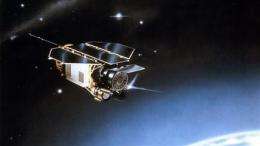Old German satellite hurtles toward Earth

A retired satellite is hurtling toward the atmosphere and pieces of it could crash into the Earth as early as Friday, the German Aerospace Center says.
Scientists are no longer able to communicate with the dead German satellite ROSAT, which orbits the earth every 90 minutes, and experts are not sure exactly where pieces of it could land.
Parts of the satellite, which is the size of a minivan, will burn up during re-entry but up to 30 fragments weighing a total of 1.87 tons (1.7 metric tons) could crash into the Earth sometime between Friday and Monday, center spokesman Andreas Schuetz told The Associated Press.
"All countries around the globe between 53-degrees north and 53-degrees south could possibly be affected," Schuetz said Wednesday - a vast swath of territory that includes much of the earth outside the poles.
The 2.69-ton (2.4 metric ton) scientific satellite was launched in 1990 and retired in 1999 after being used for research on black holes and neutron stars and performing the first all-sky survey of X-ray sources with an imaging telescope.
The largest single fragment of ROSAT that could hit into the earth is the telescope's heat-resistant mirror.
The satellite will re-enter the atmosphere at a speed of 17,400 mph (28,000 kph).
As it nears the Earth in coming days, scientists will be able to more accurately estimate exactly when it will land to a window of about 10 hours.
A dead NASA satellite fell into the southern Pacific Ocean last month, causing no damage, despite fears it would hit a populated area and cause damage or kill people.
Experts believe about two dozen metal pieces from the bus-sized satellite fell over a 500-mile (800 kilometer) span of uninhabited portion of the world.
The NASA climate research satellite entered Earth's atmosphere generally above American Samoa. But falling debris as it broke apart did not start hitting the water for another 300 miles (480 kilometers) to the northeast, southwest of Christmas Island.
Earlier, scientists had said it was possible some pieces could have reached northwestern Canada.
The German space agency puts the odds of somebody somewhere on Earth being hurt by its satellite at 1-in-2,000 - a slightly higher level of risk than was calculated for the NASA satellite. But any one individual's odds of being struck are 1-in-14 trillion, given there are 7 billion people on the planet.
More information: The German space agency on ROSAT: http://bit.ly/papMAA
©2011 The Associated Press. All rights reserved. This material may not be published, broadcast, rewritten or redistributed.


















